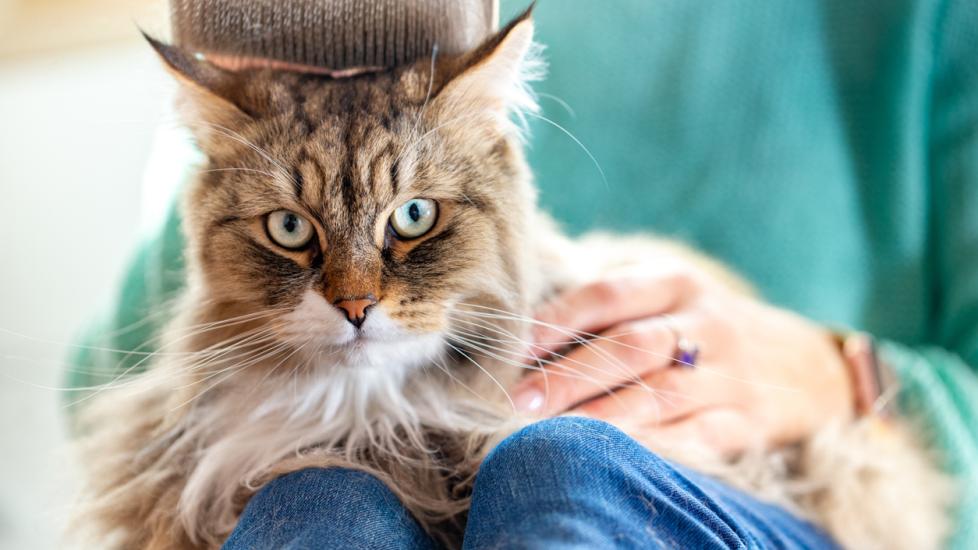How to Get Rid of Cat Fleas Naturally
Fleas are frustrating pests to treat especially when dealing with a flea infestation on your cat. Prescription flea prevention medication, combined with natural remedies, may be the best way to prevent and rid your cat of fleas.
While natural products may be helpful, the best way to rid your cat of fleas is to consult with your veterinarian for a safe and effective flea treatment plan.
Why It's Important to Check Your Cat for Fleas
Regularly checking your cat for fleas ensures early detection of a flea infestation. When you are checking your cat for fleas, make sure you look closely at the neck, armpits, groin, and tail, which are favored areas for fleas to hide.
Signs of flea infestation include:
-
Ear and neck scratching
-
Scabs
-
Hair loss
-
Skin redness
-
Black specks in the cat’s fur
Fleas commonly cause skin irritation and may transfer intestinal parasites and other illnesses to your cat. Checking your cat for fleas frequently minimizes any secondary issues they may cause.
What To Do if You Find Fleas on Your Cat
If you find fleas on your cat, don’t panic. There are several easy things you can do.
First, consult with your veterinarian. He or she may suggest bringing your cat in for a checkup and then prescribe a flea treatment and prevention medication, as well as different natural ways to kill fleas.
Keep in mind that if one pet in your home has fleas, it’s very likely that all pets in the home have fleas and will require treatment as well. Be sure to check each pet for signs of fleas.
Natural Ways for Getting Rid of Cat Fleas
It is important to listen to your veterinarian’s advice for proper treatment of your cat’s flea infestation.
In addition to finding the right medication to rid your cat of fleas, your vet can discuss different natural ways to help speed up the flea removal process.
-
Grooming/brushing: Combing daily, especially with a flea comb, can remove live and dead fleas from your cat. Concentrate on areas where fleas like to hide, like the neck, armpits, groin, and the base of your cat’s tail.
-
Shampoos: Bathing your cat with a pet-specific flea shampoo also removes fleas. Follow the recommendations on topical flea preventions to ensure you are not decreasing the product’s efficacy with increased bathing. Shampoos labeled for fleas will dry your pet’s skin and should be used with caution.
-
Dawn dish soap may be used for bathing cats with live fleas. The soap kills the fleas on your cat but does not prevent them from returning. Using a flea comb during and/or after bathing removes live and dead fleas.
-
-
Vacuuming: Daily vacuuming of your floors can kill fleas in all stages of their life cycle.
-
Treat the Yard: Limiting or eliminating your cat’s outdoor exposure to fleas is ideal. If it’s not possible, planting Lavender and marigold—or using decorative cedar chips—will help repel fleas from your yard. Diatomaceous earth or boric acid may also be used in the home and yard to treat large areas against fleas.
Treatment Options for Fleas on Cats
The mainstay of flea treatment in cats is topical or oral flea preventatives. Your veterinarian will likely prescribe one of the following flea medications to treat your cat. If your cat has secondary health concerns, your vet may prescribe different or additional medications.
Topical preventions include:
Oral preventions include:
Contrary to what you might have heard or read garlic, essential oils, apple cider vinegar, baking soda, coconut oil, brewer's yeast, and Listerine are unsafe and ineffective in preventing or treating flea infestations.
The easiest way to ensure that your cat does not get a flea infestation is to give it flea prevention medication year-round. This includes your indoor cat, since it’s not uncommon for indoor cats to also get fleas.
Featured Image: iStock.com/CasarsaGuru
Help us make PetMD better
Was this article helpful?
